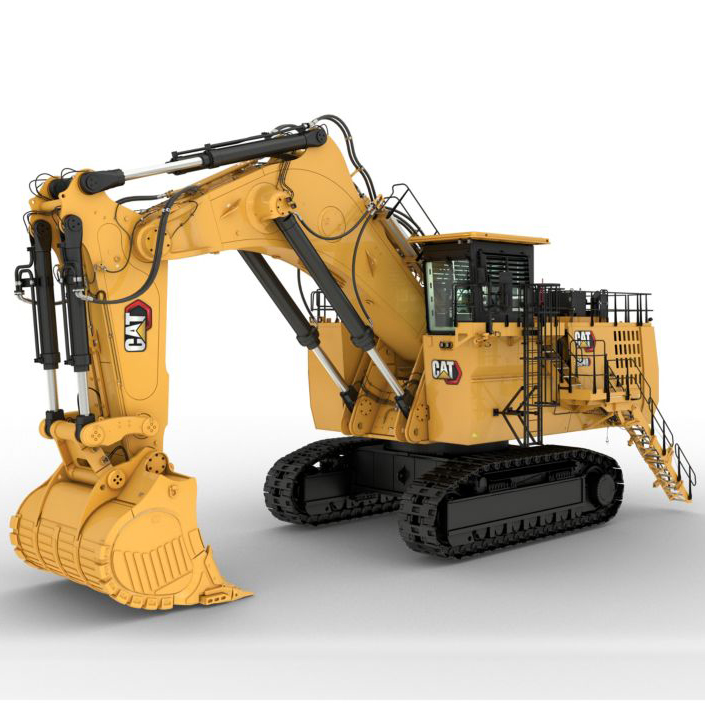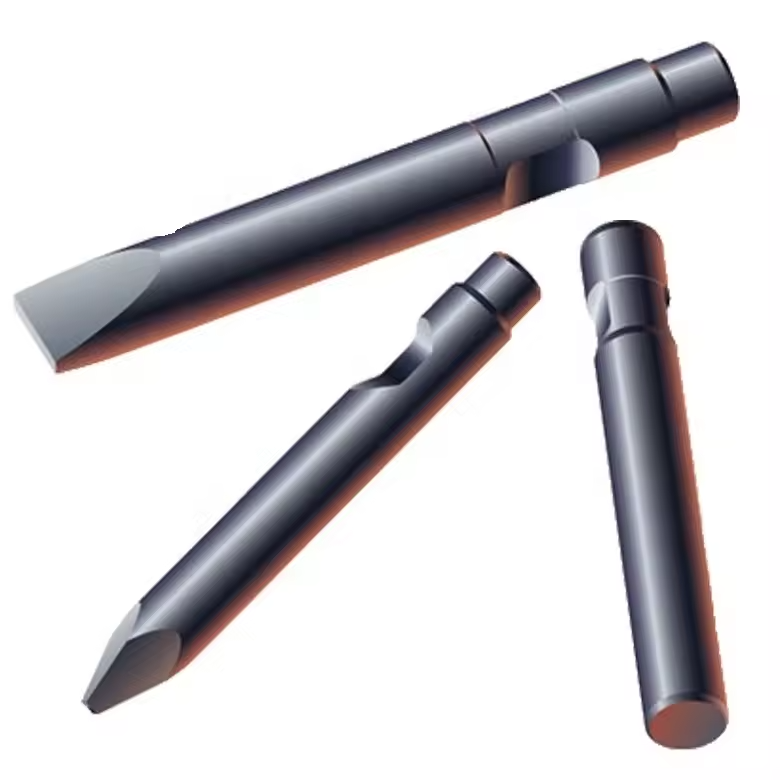
The matching of drill rod diameter and excavator tonnage is the core premise of efficient and safe crushing operation. Its standard is based on three major factors: hydraulic system parameter matching, mechanical structure bearing capacity, and operating efficiency balance. The following are the industry’s general matching standards and technical logic:
| Excavator tonnage (tons) | Recommended drill rod diameter (mm) | Suitable breaker type | Hydraulic flow demand (L/min) | Working pressure (MPa) | Typical work intensity (hours/day) |
| 1-3 tons | 30-45 | Straight type (short wheelbase design) | 20-40 | 16-18 | ≤4 hours (avoid overloading the forearm) |
| 3-6 tons | 45-68 | Straight / Lightweight Triangle | 40-70 | 18-22 | 4-6 hours (medium load) |
| 6-15 tons | 68-100 | Standard triangle | 70-120 | 22-25 | 6-8 hours (heavy duty) |
| 15-25 tons | 100-135 | Heavy duty triangle | 120-180 | 25-30 | More than 8 hours (continuous operation) |
| 25 tons + | 135+ | Extra Heavy Duty Triangle / Articulated | 180+ | 30+ | Hydraulic cooling system is required |
Core logic:
For every 1 ton increase in tonnage, the diameter of the drill rod can increase by about 10-15mm (small segment) or 5-10mm (large segment), showing a nonlinear growth, because the hydraulic power of large equipment is more significantly increased.
a. Relationship between flow rate (L/min) and drill rod diameter
Formula reference:
Drill rod diameter (mm) ≈ 1.2 × hydraulic flow rate (L/min) ÷ 10
(Applicable to 6-15 ton models, error ±5mm)
Case:
The hydraulic flow rate of a 10-ton excavator is 100L/min. According to the formula, the matching drill rod diameter is ≈12mm, but it actually needs to match a 85-90mm drill rod, because 20% flow redundancy needs to be reserved to deal with impact loads.
b. Conversion between working pressure (MPa) and crushing force
Crushing force (kN) = working pressure (MPa) × piston area (cm²) × efficiency coefficient (0.8-0.9)
Example:
When the drill rod is 100mm and the piston diameter of the breaker is 120mm, and the working pressure is 25MPa:
Piston area = π×(12/2)² = 113.1cm²
Crushing force ≈ 25×113.1×0.85 ≈ 2400kN (equivalent to 240 tons of impact force)
An excavator of more than 15 tons is required to withstand the reaction force and avoid the arm from breaking.
c. Oil return pressure limit
The oil return pressure of the breaker needs to be ≤ the design value of the excavator hydraulic system (usually ≤8MPa). If the diameter of the drill rod is too large, resulting in excessive oil return resistance (e.g., if a 10-ton machine is forced to use a 135mm drill rod, the oil return pressure may reach 12MPa), it will cause hydraulic oil overheating (oil temperature > 90℃) and seal damage.

a. Connection strength
Straight breaker: directly connected to the excavator arm through a flange, suitable for models below 6 tons (arm thickness ≤ 30mm), and can withstand lateral forces ≤ 50kN.
Triangular breaker: connected through a triangular bracket to disperse the impact force, must be used for models above 6 tons (bracket tensile strength ≥ 600MPa), and can withstand lateral forces > 100kN.
b. Center of gravity matching and stability
The center of gravity of the breaker must be within ±15° of the extension line of the center of gravity of the excavator arm, otherwise it will lead to:
Small tonnage model (<6 tons): The whole machine tilts up during operation (angle from the ground>10°), and a counterweight is required (usually 1.5 times the weight of the breaker).
Large tonnage model: If the drill rod is too thin (such as 85mm drill rod for 20-ton machine), it will cause energy dispersion during impact and the crushing efficiency will drop by about 30%.
c. Matching pipeline specifications
For every 20mm increase in the diameter of the drill rod, the inner diameter of the oil pipe needs to be increased by one level (e.g. φ19mm oil pipe for 40mm drill rod, φ32mm oil pipe for 100mm drill rod), otherwise the pressure loss will be greater than 20% (e.g. 20MPa pressure will drop to 16MPa after passing through the capillary tube).
a. High-frequency crushing operations (such as mines)
Downgrade matching is required: the 20-ton machine is originally adapted to 135mm drill rods. If the daily operation is greater than 10 hours, it is recommended to use 125mm drill rods to reduce the load on the hydraulic system and extend the life of components (the life of the cylinder seal can be increased from 800 hours to 1200 hours).
b. Vertical downward crushing (such as pile hole)
Can be upgraded to level 1 drill rod: 10-ton machine conventionally uses 90mm drill rod, and 100mm drill rod can be used for a short time during vertical operation (single continuous operation needs to be controlled to less than 30 minutes), using gravity to enhance penetration, but the arm cylinder pressure needs to be monitored (not to exceed 110% of the rated value).
| Error Type | Typical scenarios | Direct consequences |
| Sledgehammer with small machine | 8 ton machine mounted 100mm breaker | Cracks in the forearm (stress concentration), burnout of the hydraulic pump |
| Small hammer with big machine | 20 ton machine mounted 85mm breaker | Low rock crushing efficiency (rock breaking speed < 5m³/h), abnormal wear of drill rod (lifespan shortened by 50%) |
| Traffic does not match | Insufficient flow rate, forced operation | The hammer’s striking frequency dropped suddenly (from 900 times/min to 400 times/min), the piston stuck |
| Pressure Exceeded | Oil return pressure>8MPa | Multi-way valve seal leakage, oil tank oil spray (oil temperature > 100℃) |
Contact With Us
If you have any questions please fell free to contact with us.